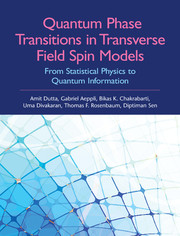 Quantum Phase Transitions in Transverse Field Spin Models
Quantum Phase Transitions in Transverse Field Spin Models Book contents
- Frontmatter
- Dedication
- Contents
- List of Figures and Tables
- Preface
- Acknowledgements
- I An Introduction to Quantum Phase Transitions, Information and Dynamics
- II Transverse Field Models: Statics
- III Transverse Field and Related Models: Non-Equilibrium Dynamics
- IV Experimental Realizations of Transverse Field Models
- V Quantum Annealing and Adiabatic Quantum Computations Using Transverse Field Models
- 15 Adiabatic Quantum Computations and Transverse Field Models
- 16 Concluding Comments
- Appendix A Derivation of a Matrix Product Hamiltonian
- Appendix B From Jordan–Wigner to Bosonization: Tomonaga–Luttinger Liquids
- Appendix C Calculation of the Entanglement Entropy for a Transverse Ising Chain
- Appendix D The Loschmidt Echo for the One-Dimensional XY Model
- Appendix E Landau–Zener Tunneling: Calculation of Non-Adiabatic Transition Probability
- Appendix F A Note on the Theoretical Studies of Hysteresis
- References
- Index
- Plate Section
15 - Adiabatic Quantum Computations and Transverse Field Models
from V - Quantum Annealing and Adiabatic Quantum Computations Using Transverse Field Models
Published online by Cambridge University Press: 05 May 2015
- Frontmatter
- Dedication
- Contents
- List of Figures and Tables
- Preface
- Acknowledgements
- I An Introduction to Quantum Phase Transitions, Information and Dynamics
- II Transverse Field Models: Statics
- III Transverse Field and Related Models: Non-Equilibrium Dynamics
- IV Experimental Realizations of Transverse Field Models
- V Quantum Annealing and Adiabatic Quantum Computations Using Transverse Field Models
- 15 Adiabatic Quantum Computations and Transverse Field Models
- 16 Concluding Comments
- Appendix A Derivation of a Matrix Product Hamiltonian
- Appendix B From Jordan–Wigner to Bosonization: Tomonaga–Luttinger Liquids
- Appendix C Calculation of the Entanglement Entropy for a Transverse Ising Chain
- Appendix D The Loschmidt Echo for the One-Dimensional XY Model
- Appendix E Landau–Zener Tunneling: Calculation of Non-Adiabatic Transition Probability
- Appendix F A Note on the Theoretical Studies of Hysteresis
- References
- Index
- Plate Section
Summary
Multivariable optimization problems belong to an interdisciplinary field of research connecting diverse fields like computer science, information theory and statistical physics. It involves finding an optimal solution out of the many available states or configurations, possibly satisfying a set of constraints. For physicists, the problem can be visualized as finding the global minima of the energy landscape of a given complex Hamiltonian, which is quite difficult to obtain by the obvious method of examining the energy of each state. This is due to the huge number of available states which grows exponentially with the system size (for N Ising spins, the configuration space grows as 2N). The search for such a global minimum becomes all the more complex when the landscape consists of several local minima separated by macroscopic barriers (O(N)) arising from frustrating constraints in the systems. To solve such an optimization problem in a stochastic case, the concept of simulated annealing (SA) was put forward by Kirkpatrick et al. [437]. In this method, a tunable noise is artificially induced (thermal-like fluctuations equivalent to that of a metallurgical annealing) which helps the system to escape from the local minima by hopping above the energy barriers, and staying longer in minimum energy valley(s) as the noise variable is slowly reduced to zero starting from a high value. At the same time, it is also known that in complex systems, due to many closely spaced low lying states, the annealing needs to be performed infinitely slowly to reach the true ground state; this is indeed a major drawback. We shall elaborate on this point later when we discuss the effect of system size on the minimum gap between the ground state and the first excited state of the quantum many body system under consideration. The numerical methods used in such studies are variants of Monte Carlo methods.
- Type
- Chapter
- Information
- Quantum Phase Transitions in Transverse Field Spin ModelsFrom Statistical Physics to Quantum Information, pp. 247 - 264Publisher: Cambridge University PressPrint publication year: 2015
